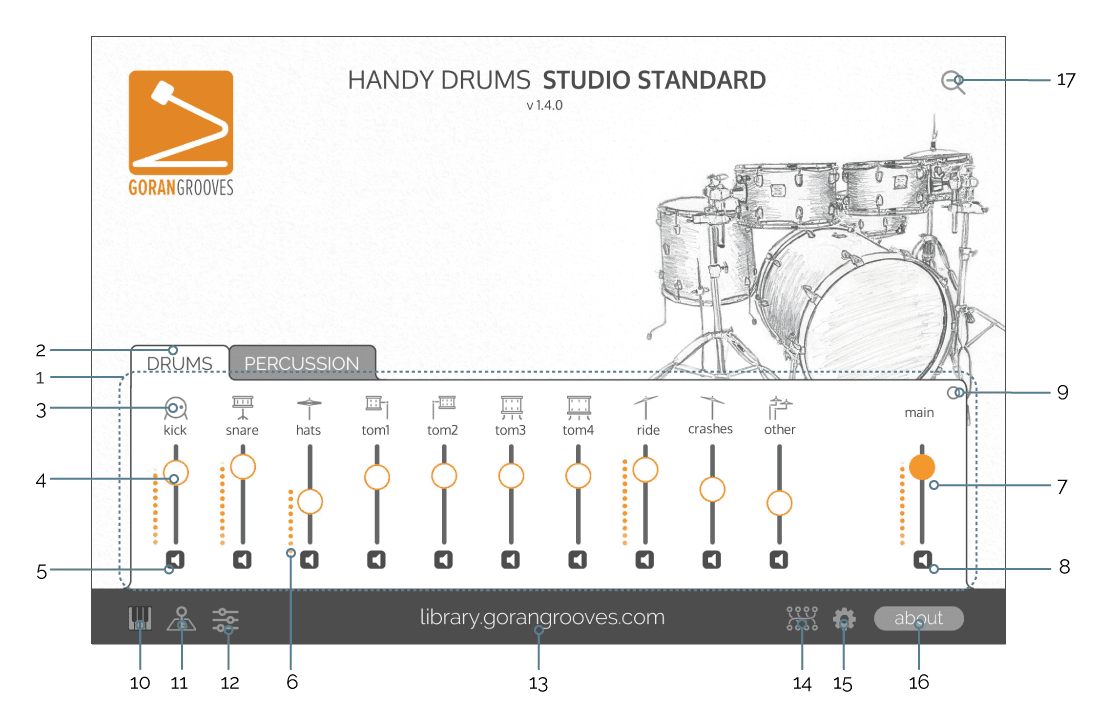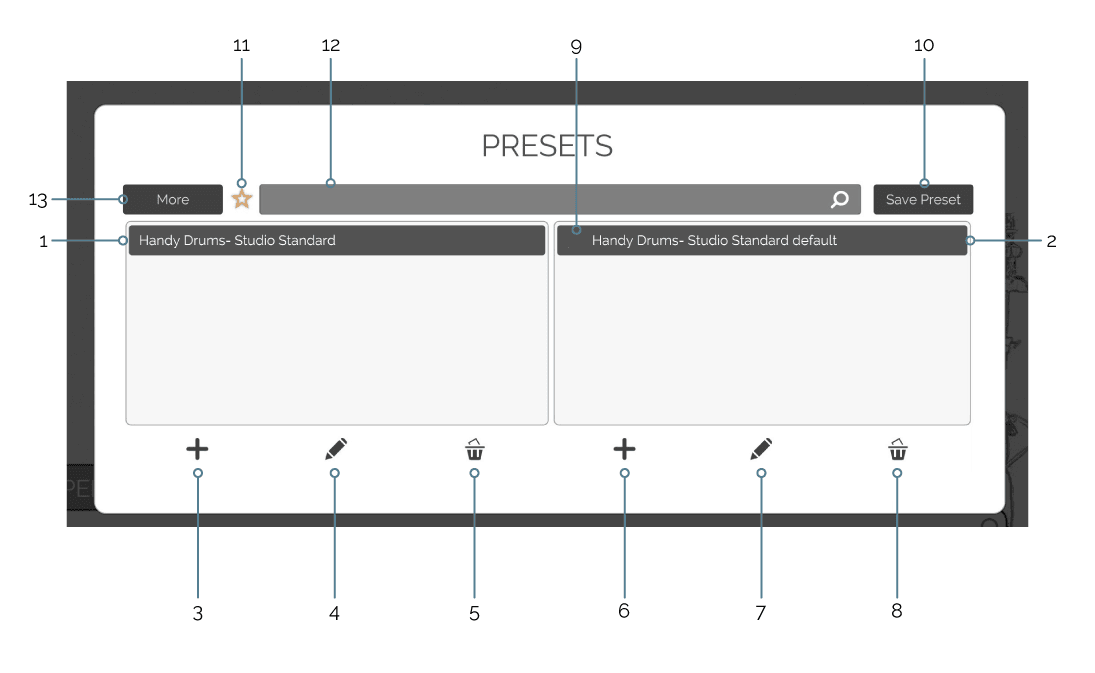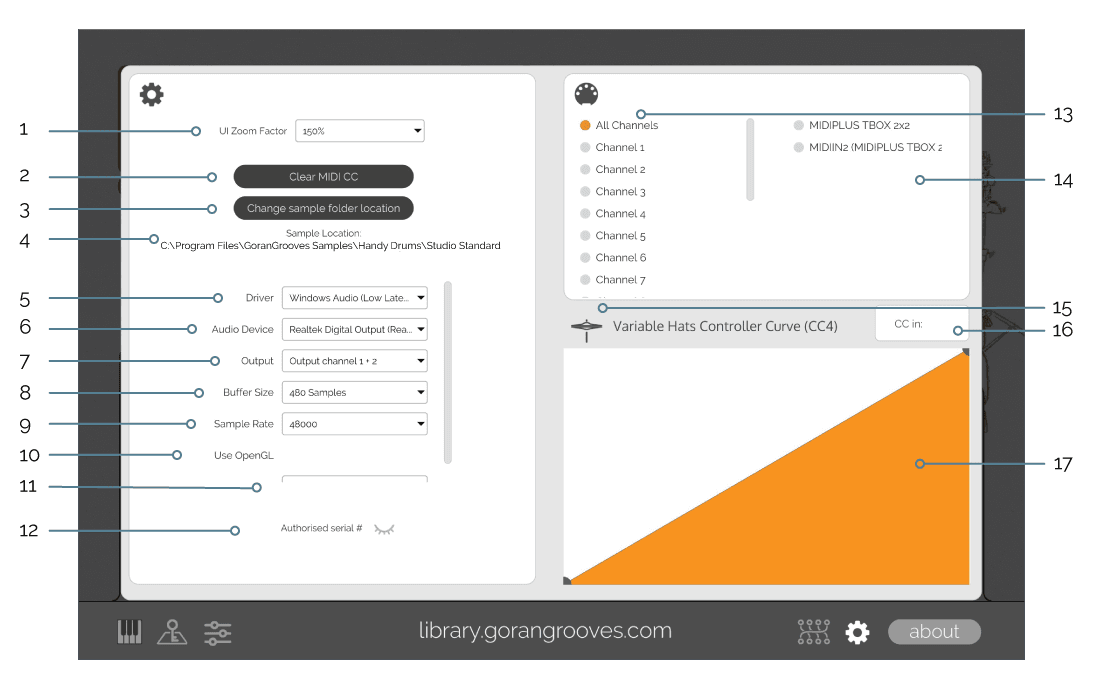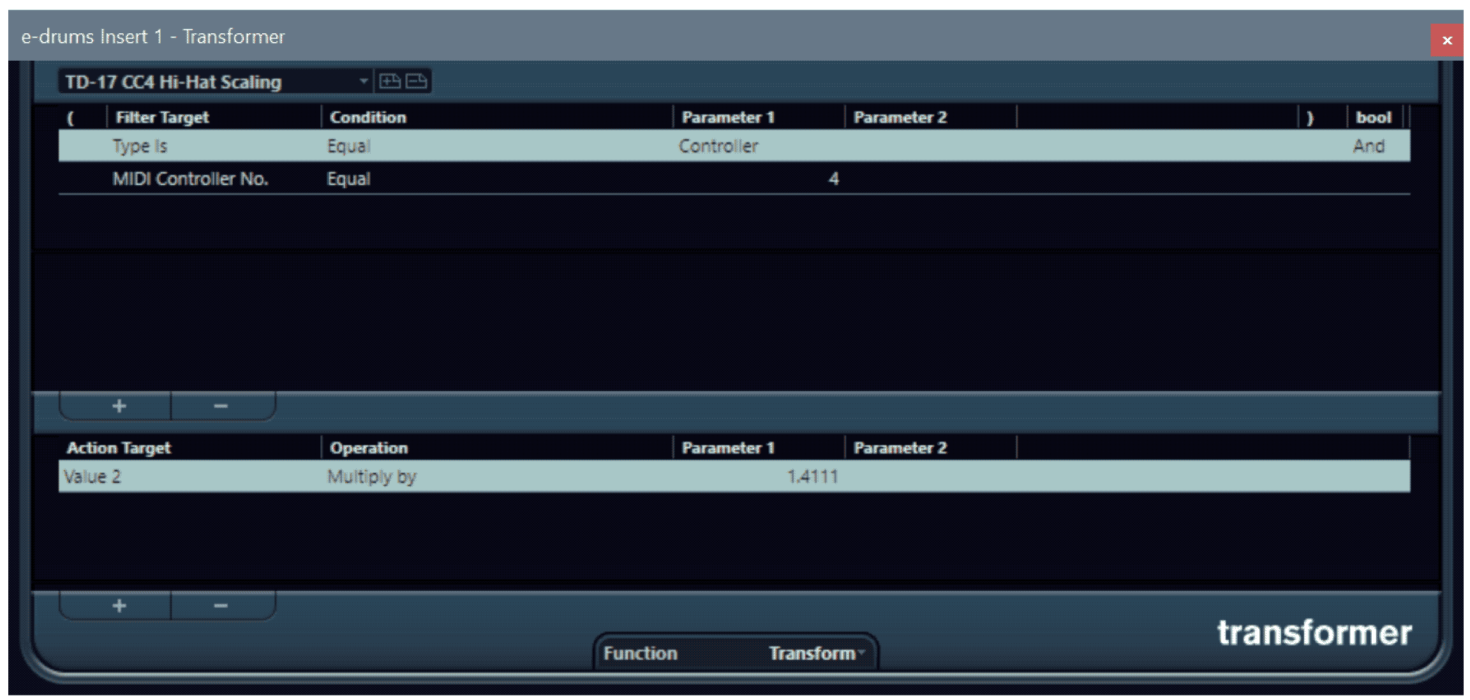- Introduction
- GUI Main
- Main Mixer Panel
- Drums / Percussion Tabs
- Instruments Audition- button
- Volume Slider
- Mute Button
- Gain Output Meters
- Main Output Slider
- Main Output Mute Button
- Subgroups Panel expand button
- Keyboard Display Button
- Key (Drum) Mapping Button
- Preset Manager button
- Clickable URL to GoranGrooves Library
- Output Routing Button
- Settings button
- About button
- Zoom factor button
- Key (Drum) mapping Panel
- Preset Manager Panel
- Settings Panel
- UI Zoom Factor
- Clear MIDI CC
- Change Sample Folder Location- button
- Sample Location Display
- Driver *
- Audio Device *
- Output Channel *
- Buffer Size *
- Sample Rate *
- Use open GL
- Streaming Mode *
- Authorized Serial # (License Key)
- MIDI Channels
- MIDI Device List *
- Variable Hats animated icon
- CC In #
- Variable Hats Controller Curve (CC4)
- Modifying CC4 input sent from drum modules
- Hidden Features
For Handy Drums V1.
For the latest documentation for Handy Drums v2, see this document.
Introduction #
We designed the Handy Drums to be straightforward to use and to give you beautiful, produced, finished drum sound right from the get-go.
While most of the functions can be viewed from the simple graphic user interface (GUI), behind the scenes are 50+ powerful individual samplers and practical algorithms working in unison to create a seamless playback. There are also certain functionalities not apparent from the interface.
Most Handy Drums plugins utilize a variable hi-hat system, enabling you to adjust how open or closed hi-hat sounds on the fly. You accomplish that by using CC4. We cover that functionality in detail in this doc.
Most drum components (e.g., kick, snare, toms) have a linear volume response. The highest velocity value of 127 will respond to 0db on a digital scale, while half velocity of 64 will respond to -6db. The velocity of 32 will output -12db and so on. All velocity values in between will smoothly attenuate the volume output.
GUI Main #

Hidden feature- Learn midi/ Assign midi ID
Hidden feature- update notification
Hidden feature- Variable hi-hats
Main Mixer Panel #
This panel holds the most fundamental and frequently used elements. All Handy Drums instruments, including those with a vast number of instruments (Latin Percussion & Drums, Studio Standard, World Percussion), are split into drums and percussion panels. You can switch between them by clicking on the panel tabs.
Drums / Percussion Tabs #
Every Handy Drums plugin contains several or a full suite of percussion instruments that have their dedicated group. Switch between the drums and percussion group views by using the tabs.
Instruments Audition- button #
Clicking on icons will preview the sounds of the respective instrument components. With each mouse click, samples will be re-triggered at random velocities. Since some icons represent a group of instruments (e.g., crashes, percussion), they will be played consecutively on each mouse click.
Volume Slider #
Sliders control instrument components’ output levels. Sliders control either an individual component (kick, tom) or a component sub-group (snare/ snare cross-stick, ride/ ride bell).
The values range from 0.00 to 1.00 in 0.01 increments and are displayed once a slider is pressed or moved.
Mute Button #
The mute button mutes the channel or sub-group output. Pressing it again unmutes the channel/ sub-group.
Known issue: If pressed during playback, all components will briefly mute until the following note is triggered.
Gain Output Meters #
All channels, sub-groups, and the main output contain gain meters. The meters are only visible when a signal is present in their respective outputs.
Currently, the subgroup meters and the main meter will be visible only when their outputs are routed to outputs 1-2.
Main Output Slider #
This slider controls the main output of the plugin. The values range from 0.00 to 1.00 in 0.01 increments and are displayed once a slider is pressed or moved.
Main Output Mute Button #
This button mutes/unmutes the master output of the plugin.
Subgroups Panel expand button #
Clicking on this button will expand the subgroup panel for drums and percussion.
Subgroup Panel #
The Subgroup Panel contains drums and percussion groups’ faders, gain meters, mute buttons, and routing outputs (when enabled).
Keyboard Display Button #

Pressing this button will display/hide a small virtual keyboard panel in the lower portion of the plugin.
Virtual Keyboard Panel #
The keyboard shows all notes occupied by the plugin and allows you to audition them. The utilized notes are marked in orange and will reflect any changes in drum mapping.
To see the notes you play on a midi controller reflected in this keyboard display, your MIDI track needs to be set to channel 10. This visual feedback will only show in DAW’s and not in standalone apps.

Virtual CC4 mod wheel #
Next to the virtual keyboard, you will find the virtual mod wheel connected to CC4. The modwheel will reflect any CC4 messages coming in from your DAW or a MIDI controller, used to control the openness of the variable hi-hats. You can operate the virtual mod wheel using your mouse cursor or its wheel.
You can assign any additional CC# to the variable hi-hats using this virtual mod wheel. To assign a CC# to the variable hi-hats, do one of the following:
- Right-click on the virtual mod wheel, select “Assign MIDI CC”, then pick any from the available list, or
- Right-click on the virtual mod wheel, select “Learn MIDI CC” and move a slider or a knob on your MIDI controller, instantly assigning it to the variable hats (in addition to CC4).
The animated hi-hat audition button will also display the action generated by the CC4 or any other CC assigned to the variable hi-hats.
Key (Drum) Mapping Button #

Pressing this button will open/close the key mapping panel, where you can assign any note to an instrument in several ways.
Preset Manager button #

Click this button when you want to speak to the manager. The Preset Manager panel will magically appear and grant you 3 wishes, such as recalling the default plugin state or saving your current setup.
Clickable URL to GoranGrooves Library #
Clicking on this link will open up your default browser and take you to GoranGrooves Library.
Output Routing Button #

This button will open/close the output routing panel for all channels/ subgroups. It will be displayed just under the volume sliders.
Output Routing #
Each output selection corresponds to the channel/ sub-group above it. By default, all channels are routed to a single stereo output (channels 1+2). There are a total of 8 stereo outputs available in the plugin.
To route a component (e.g., snare) to a different output, click on the output box and select one of the 8 available stereo outputs.
Note: Multiple outputs are only functional when the plugin is used within a DAW. Changing the output to anything other than the “1+2” stereo pair in the standalone app will make that channel inaudible.
Enabling Plugin Multiple Outputs #
For multiple outputs to function as intended within a DAW, you must also enable multiple outputs for the plugin. Please consult your DAW’s manual on “how to enable multiple outputs on a virtual instrument.”
For your convenience, we have put together info for several DAWs.
Enable Multiple Plugin Outputs In Steinberg Cubase / Nuendo
Enable Multiple Plugin Outputs in Presonus Studio One
Enable Multiple Plugin Ouputs In Apple Logic Pro X
Enable Multiple Plugin Outputs In Image-Line FL Studio
Enable Multiple Plugin Outputs in Avid Pro Tools
Once you enable multiple plugin outputs within your DAW, you can route various instruments inside Handy Drums to any available outputs. The change will be reflected in the plugin output channels in your DAW. This will allow you to manipulate those output groups further: automate volume and add effects, for example.
Settings button #

This button will show/hide the main settings panel.
About button #

Clicking this button will show/hide the information about the plugin developers.
Zoom factor button #

This will open up the secondary zoom factor panel and allow you to set the size of the entire GUI. It is particularly handy if the default plugin size is greater than your screen and you cannot reach the settings panel at the bottom of the plugin.
Key (Drum) mapping Panel #
The Key (Drum) Mapping panel displays the current mapping of all individual drum and percussion components included in the plugin and allows you to assign them to different notes.
Learn Note #
There are two ways to assign a drum/ percussion component to a different note:
1- click on the note box and select from the popup of all available notes, or
2- Click on the learn note button next to an instrument and strike a key (either on the plugin’s virtual keyboard or a physical MIDI controller connected to the plugin). The instrument will be instantly assigned to the note/key you just played.
Note Indicators #
Note indicators present next to each instrument mapping box will illuminate orange whenever that instrument is triggered via MIDI. It helps with knowing what instrument is currently being played.
MIDI IN# and CC IN# Display Panel #
The panel at the very top of the mapping panel will display the most recently-played note, as well as CC.
Preset Manager Panel #
The preset manager allows you the save the current full state of the plugin. All parameters are saved at once, and they include the following:
- Drum mapping
- Output channel routing
- Volume faders (sliders)
- Mute buttons status
- Drum / Percussion Tab selection

- Bank name
- Preset name
- Create new bank
- Rename current bank
- Delete current bank
- Create new preset
- Rename current preset
- Delete current preset
- Mark preset as “favorite”
- Overwrite the selected preset with the current state of the plugin
- Show only favorite presets
- Search through available presets
- Additional preset functions
Each Handy Drums plugin comes with a single default preset which matches the settings that load once the plugin is initialized within a DAW session or in standalone mode.
The preset manager organizes presets in banks (left column), which, when clicked, display available presets within them in the right column. A preset is recalled instantly once a preset name is clicked on.
The additional preset functions:
- Show preset folder
This will open up the applications folder for the plugin in your OS and select the “User presets” folder.
- Import all presets from Clipboard
Import the previously-exported compressed version of your presets from another Handy Drums plugin.
- Export all presets to Clipboard
Using this function will create a compressed version of all of your presets in the form of gibberish text onto your Clipboard, which you can then import into another Handy Drums plugin.
- Import all presets as Collection
Import the previously exported .hpa presets collection from a Handy Drums plugin.
- Export all presets as Collection
A neat way to export all your presets into a single file, which can then be shared or imported into another Handy Drums plugin. The preset collection has a .hpa file name extension.
Note: Since the preset manager saves the entire plugin’s state, importing presets from other Handy Drums plugins can have unexpected results if the number of available instruments doesn’t match.
Settings Panel #

UI Zoom Factor #
This control sets the size of the plugin’s GUI. By default, the plugin is set to 100%. You can make it smaller at 50% and 75% or larger at 125% and 150%.
Clear MIDI CC #
This button clears any currently present CC messages.
Change Sample Folder Location- button #
If you didn’t manually relocate the sample library after the installation, you don’t need to touch this.
Use this button to set the folder where your sample library is located.
After you change the location, you will be prompted to reload your plugin for the changes to take effect.
Sample Location Display #
This is the current location of your sample library for this plugin.
Driver * #
The audio driver protocol available on your system. We recommend the ASIO type. For standalone app, a different driver may yield a better result. Test to see what works best on your system.
Audio Device * #
This is the audio device available under your chosen driver above.
Output Channel * #
Select the audio output available from your selected Audio Device.
Buffer Size * #
A larger buffer size will reduce your computer’s CPU load but will result in increased latency. Choose the lowest possible settings where you are getting a clean audio output and steady performance.
The buffer size should be set to a multiple of 8 (eg. 64, 128 etc.) or you may get unpredictable results.
Sample Rate * #
The sample library is provided at 44.1KHz, so the recommended setting here is 44100.
Use open GL #
On by default.
Streaming Mode * #
Pick the kind of disc drive you are utilizing for the Handy Drums samples for optimum plugin performance. Available options are FAST- SSD and SLOW HDD.
* These features are only available in the standalone app. When used inside a DAW, they are not available in the plugin, as those options are set and controlled by the DAW.
Authorized Serial # (License Key) #
Click on the eye icon to reveal the serial number you registered for the plugin in use.
MIDI Channels #
There are 16 available MIDI channels. Unless you have a specific reason to change it, you can leave the setting on “All Channels.”
MIDI Device List * #
This list displays all available MIDI input devices currently present in your system. If you don’t see a device you expect, make sure that it is plugged in and switched on. You may need to restart the standalone app for them to be recognized.
To enable MIDI input, select the device and MIDI input from the available list.
Variable Hats animated icon #
The icon will simulate the opening and closing of the variable hi-hats only and will respond to all CC4 messages, as well as any CC controller you may have previously connected to the variable hats. You can manually operate this animated icon using your mouse cursor or its wheel.
CC In # #
This displays the most recently used CC#. This will help you determine what CC you are playing on your MIDI controller.
Variable Hats Controller Curve (CC4) #
For drummers using e-drums only
CC4 is generally reserved for hi-hat foot controllers. This controller regulates how tightly closed or open hi-hats are played.
The curve allows you to change the response of the CC4 values sent from the e-drums module and those received by the plugin.
Some drum modules, such as Roland TD-17, support variable hi-hats. While tightly pressing the foot controller will produce an appropriate hi-hat sound on the actual drum module, the CC4 value that it sends out via MIDI output is capped at 90 (instead of 127). That means that the drum module can never produce a closed hi-hat sound in Handy Drums without additional manipulation of the CC4 values.
This curve allows you to transpose the values sent from the drum module to the correct values for the plugin. In addition to providing a workaround for Roland’s limitations, this curve can also be used to tweak the response of the hi-hat controller.
The vertical values correspond to input values, while the horizontal corresponds to output values.
In the case of TD-17, you’ll need to adjust the curve so that the maximum tight closed hats value of 90 sent from the drum module is transposed to value 127, being played by the plugin.
By default, the curve is set not to transpose the values, and this is the setting you should leave unless you require this function.
Click anywhere on the curve module to change the curve, and a nod point will be generated. You can click and drag it. To remove a nod point, right-click on it. You can also change the curve slope by right-clicking and moving your mouse cursor.
Note: This function will not change your drum module’s values being recorded onto a MIDI track in your DAW, but only the playback. This is primarily useful for a live performance on e-drums.
Modifying CC4 input sent from drum modules #
If you intend to record the MIDI performance of your e-drums (which limit the output of CC4), it is better to apply a MIDI transformer on your MIDI track input in your DAW. That way, the correct values will be recorded into your MIDI track and will playback as intended in Handy Drums without having to touch the CC4 curve.
Steinberg’s Cubase comes with such a MIDI plugin. As shown in the image below, we set the Transformer to react to CC4 messages and multiply all incoming values by 1.4111. So, when a drum module sends out a CC4 value of 90, that gets multiplied by 1.4111, resulting in the value of 126.99 being recorded into the MIDI track.

Hidden Features #
Variable Hi-Hats #
Handy Drums plugins feature an efficient implementation of the variable hi-hats function, which is not visually apparent from the GUI.
By using CC#4 controller, you can smoothly transition from the tightly closed to 100% open hi-hats, with several stages in between.
You can also assign any additional CC# to control the variable hats openness.
Please see this in-depth post on what it is and how to use it.
Learn MIDI CC/ Assign MIDI CC #
You can assign any MIDI CC# to some elements on the GUI, which will allow you to manipulate the controls using a MIDI controller (MIDI keyboard with sliders).
To assign a physical MIDI controller to an element on the GUI (volume slider), right-click on the element (slider) and select Learn MIDI CC. Then, move the physical slider to which you want to assign this control. The physical controller that is moved first will be immediately assigned to this element.
To unassign MIDI CC from an element, right-click on it and select Remove CC.
Alternatively, you can click on Assign MIDI CC, then pick the CC# from the popup of available choices.
Note: To control the plugin parameter with a physical MIDI controller, the midi track (routed to the plugin) needs to be recording-enabled.
Software Update Notifications #

All Handy Drums plugins contain a function to automatically check for a newer plugin version and display a notification. This check is performed quietly every time a plugin is initiated. If a new version is found, an orange bell icon will illuminate next to the routing button in the bottom panel.
Clicking on the bell icon will display a popup panel with the relevant information, including a brief description and a link to read more.
To obtain the latest version, you will need to log in to your GoranGrooves account and download it from there.
